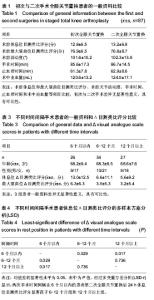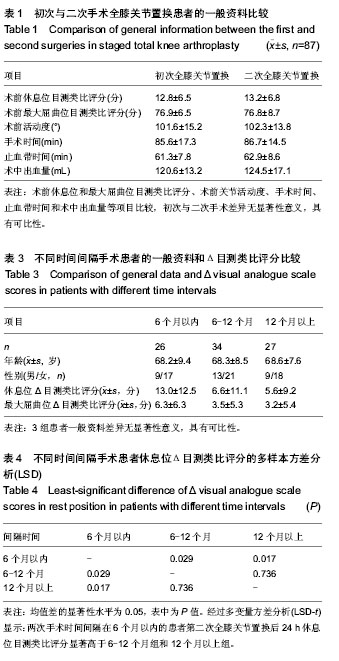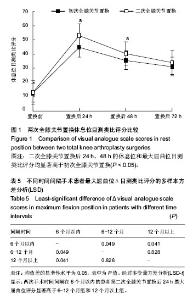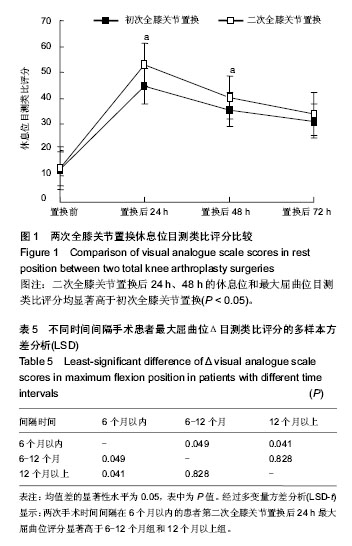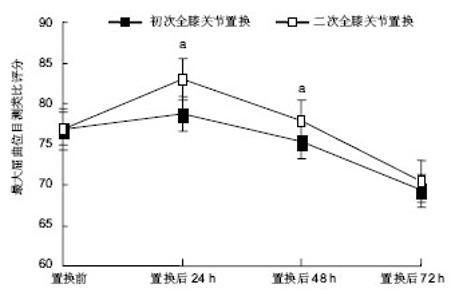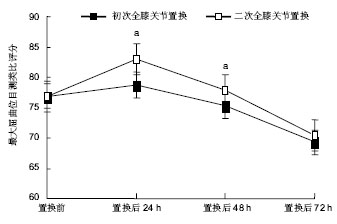Chinese Journal of Tissue Engineering Research ›› 2014, Vol. 18 ›› Issue (31): 4944-4949.doi: 10.3969/j.issn.2095-4344.2014.31.005
Previous Articles Next Articles
Early postoperative pain between the first and second staged bilateral total knee arthroplasty: a retrospective comparative analysis
Sun Jiu-yi1, Zhou Yi-qin2
- 1Department of Orthopedics, the 455 Hospital of Chinese PLA, Shanghai 200052, China; 2Second Affiliated Hospital, Second Military Medical University, Shanghai 200052, China
-
Received:2014-06-18Online:2014-07-23Published:2014-07-23 -
Contact:Zhou Yi-qin, Master, Attending physician, Second Affiliated Hospital, Second Military Medical University, Shanghai 200052, China -
About author:Sun Jiu-yi, Master, Attending physician, Department of Orthopedics, the 455 Hospital of Chinese PLA, Shanghai 200052, China
CLC Number:
Cite this article
Sun Jiu-yi, Zhou Yi-qin. Early postoperative pain between the first and second staged bilateral total knee arthroplasty: a retrospective comparative analysis[J]. Chinese Journal of Tissue Engineering Research, 2014, 18(31): 4944-4949.
share this article
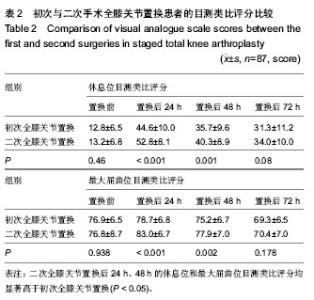
2.1 参与者数量分析 按意向性处理,纳入行分期双侧全膝关节置换的患者87例,全部进入结果分析,无脱落。 2.2 初次与二次手术基线资料比较 本组患者在初次置换和二次置换前休息位和最大屈曲位的目测类比评分、术前活动度等方面差异无显著性意义。初次与二次手术的手术总时间、止血带时间、术中出血量比较差异也未见显著性意义(表1)。 2.3 初次与二次手术目测类比评分比较 初次手术与二次手术的术后24,48,72 h目测类比评分比较结果如表2和图1,2所示。经过配对t 检验显示:两次手术在术前休息位和最大屈曲位的目测类比评分比较差异均无显著性意义,但是二次全膝关节置换后24,48 h的休息位目测类比评分和最大屈曲位目测类比评分均显著高于初次全膝关节置换。而术后72 h休息位与最大屈曲位目测类比评分则没有明显差异。 2.4 两次手术不同间隔时间对二次手术后24 h疼痛目测类比评分增加量的影响 本研究的一个亚组分析是比较两次手术不同间隔时间对二次手术后24 h疼痛目测类比评分增加量(Δ目测类比评分=二次手术目测类比评分-初次手术目测类比评分)的影响。 主要分3个时间段组:6个月以内、6-12个月、12个月以上。3组的一般资料见表3。 经过多变量方差分析(LSD-t )显示:两次手术时间间隔在6个月以内的患者第二次全膝关节置换后24 h休息位和最大屈曲位评分均显著高于6-12个月组和12个月以上组;而6-12个月组与12个月以上组的休息位和屈曲位Δ目测类比评分差异均未见显著性意义(详细统计结果见表4,5)。"
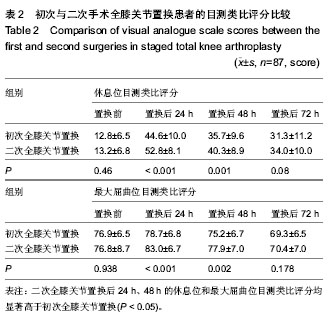
| [1] Kim S, Meehan JP ,White R. Operative risk of staged bilateral knee arthroplasty is underestimated in retrospective studies. J Arthroplasty. 2011;26: 1198-1204. [2] Leitch KK, Dalgorf D, Borkhoff CM, et al. Bilateral total knee arthroplasty--staged or simultaneous? Ontario's orthopedic surgeons reply. Can J Surg. 2005;48: 273-276. [3] Ritter M, Mamlin LA, Melfi CA, et al. Outcome implications for the timing of bilateral total knee arthroplasties. Clin Orthop Relat Res. 1997;(345):99-105. [4] Husted H, Troelsen A, Otte KS, et al. Fast-track surgery for bilateral total knee replacement. J Bone Joint Surg Br. 2011; 93: 351-356. [5] Hu J, Liu Y, Lv Z, et al. Mortality and morbidity associated with simultaneous bilateral or staged bilateral total knee arthroplasty: a meta-analysis. Arch Orthop Trauma Surg. 2011; 131(9):1291-1298. [6] Patil N, Wakankar H. Morbidity and mortality of simultaneous bilateral total knee arthroplasty. Orthopedics. 2008:31: 780-789. [7] Restrepo C, Parvizi J, Dietrich T, et al. Safety of simultaneous bilateral total knee arthroplasty. A meta-analysis. J Bone Joint Surg. 2007;89: 1220-1226. [8] Barrett J, Baron JA, Losina E, et al. Bilateral total knee replacement: staging and pulmonary embolism. The J Bone Joint Surg. 2006;88: 2146-2151. [9] Oakes DA, Hanssen AD. Bilateral total knee replacement using the same anesthetic is not justified by assessment of the risks. Clin Orthop Relat Res. 2004;(428):87-91. [10] Cohen RG, Forrest CJ, Benjamin JB. Safety and efficacy of bilateral total knee arthroplasty. J Arthroplasty. 1997;12: 497-502. [11] Odum SM, Troyer JL, Kelly MP, et al. A cost-utility analysis comparing the cost-effectiveness of simultaneous and staged bilateral total knee arthroplasty. J Bone Joint Surg. 2013;95: 1441-1449. [12] Leonard L, Williamson DM, Ivory JP , et al. An evaluation of the safety and efficacy of simultaneous bilateral total knee arthroplasty. JArthroplasty. 2003;18: 972-978 . [13] Kim YH. Incidence of fat embolism syndrome after cemented or cementless bilateral simultaneous and unilateral total knee arthroplasty. J Arthroplasty. 2001;16: 730-739. [14] Mangaleshkar SR, Prasad PS, Chugh S, et al. Staged bilateral total knee replacement--a safer approach in older patients. Knee. 2001;8, 207-211. [15] Jankiewicz JJ, Sculco TP, Ranawat CS, et al. One-stage versus 2-stage bilateral total knee arthroplasty. Clin Orthop Relat Res. 1994;(309):94-101. [16] Morrey BF, Adams RA, Ilstrup DM, et al. Complications and mortality associated with bilateral or unilateral total knee arthroplasty. J Bone Joint Surg. 1987;69: 484-488. [17] Soudry M, Binazzi R, Insall JN, et al. Successive bilateral total knee replacement. J Bone Joint Surg. 1985:67: 573-576 . [18] Cross WW 3rd, Saleh KJ, Wilt TJ, et al. Agreement about indications for total knee arthroplasty. Clin Orthop Relat Res. 2006;446:34-39. [19] Carli F, Charlebois P, Stein B, et al. Randomized clinical trial of prehabilitation in colorectal surgery. Br J Surg. 2010;97: 1187-1197. [20] Grosu I, Lavand'homme P, Thienpont E. Pain after knee arthroplasty: an unresolved issue. Knee Surg Sports Traumatol Arthrosc. 2013. [Epub ahead of print] [21] 张飞,李奇,林荔军,等.联合多模式镇痛在全髋关节置换术后的早期疗效[J].中华关节外科,2013,7(3): 33-35. [22] 龙成,孙俊英,刘跃洪,等.全膝关节置换术围手术期多模式镇痛的临床研究[J].中华关节外科, 2009,3(6):30-33. [23] 符培亮,吴宇黎,吴海山,等.全膝置换术后关节内注射鸡尾酒式镇痛混合剂对镇痛效果的评价[J].中华骨科杂志,2008,28(7): 541-545. [24] Qutob M, Winemaker M, Petruccelli D, et al. Staged bilateral total knee arthroplasty: does history dictate the future? J Arthroplasty. 2013;28:1148-1151. [25] Jenny JY, Trojani C, Prudhon JL, et al. Simultaneous bilateral total knee arthroplasty. A multicenter feasibility study. Orthop Traumatol Surg Res. 2013;99: 191-195. [26] Vulcano E, Memtsoudis S, Della Valle AG. Bilateral total knee arthroplasty guidelines: are we there yet? J Knee Surg. 2013; 26: 273-279. [27] Memtsoudis SG, Mantilla CB, Parvizi J,et al. Have bilateral total knee arthroplasties become safer? A population-based trend analysis. Clin Orthop Relat Res. 2013;471: 17-25. [28] Kim MH, Nahm FS, Kim TK,et al. Comparison of postoperative pain in the first and second knee in staged bilateral total knee arthroplasty: Clinical evidence of enhanced pain sensitivity after surgical injury. Pain. 2014; 155(1):22-27. [29] Woolf CJ. Central sensitization: implications for the diagnosis and treatment of pain. Pain 2011;152: S2-15. [30] Woolf CJ, Salter MW. Neuronal plasticity: increasing the gain in pain. Science. 2000;288:1765-1769. [31] Suzuki R, Dickenson A. Spinal and supraspinal contributions to central sensitization in peripheral neuropathy. Neurosignals. 2005;14: 175-181. [32] Wieseler-Frank J, Maier SF, Watkins LR. Glial activation and pathological pain. Neurochem Int. 2004;45: 389-395. [33] Suokas AK, Walsh DA, McWilliams DF, et al. Quantitative sensory testing in painful osteoarthritis: a systematic review and meta-analysis. Osteoarthritis Cartilage. 2012;20: 1075-1085. [34] Arendt-Nielsen L, Nie H, Laursen MB, et al. Sensitization in patients with painful knee osteoarthritis. Pain. 2010;149: 573-581. [35] Collett BJ. Opioid tolerance: the clinical perspective. Br J Anaesth. 1998;81: 58-68. [36] Goldstein A , Sheehan P. Tolerance to opioid narcotics. I. Tolerance to the "running fit" caused by levorphanol in the mouse. J Pharmacol Exp Ther. 1969;169: 175-184. [37] Yaksh TL. In vivo studies on spinal opiate receptor systems mediating antinociception. I. Mu and delta receptor profiles in the primate. J Pharmacol Exp Ther. 1983;226: 303-316. [38] Wortzel HS, Frey KL, Anderson CA, et al. Subtle neurological signs predict the severity of subacute cognitive and functional impairments after traumatic brain injury. J Neuropsychiatry Clin Neurosci. 2009;21: 463-466. |
| [1] | Jin Rui, Liu Ying, Yao Yao, Liu Ya-fei, Tao Hui, Du Shan-shan, Chen Hui, Liu Jun. Rehabilitation satisfaction of Taohong Siwu Decoction combined with acupoint moxibustion applied in older adults after total knee arthroplasty [J]. Chinese Journal of Tissue Engineering Research, 2018, 22(27): 4271-4276. |
| [2] | Liu Sheng-fa, Zhang Feng. Kinesio taping combined with manual lymphatic drainage for lower limb swelling after total knee arthroplasty [J]. Chinese Journal of Tissue Engineering Research, 2017, 21(11): 1647-1651. |
| [3] | Abudunaibi•Aili, Zhang Hong-qi, Huang Wei-min, Li Lei, Tian Hui-zhong. Special formed titanium mesh cages for treating spinal tuberculosis via one-stage posterior approach [J]. Chinese Journal of Tissue Engineering Research, 2016, 20(48): 7192-7199. |
| [4] | Yuan Feng, Lu Hai-tao, Deng Bin, Li Zhi-duo, Li Wei, Wu Ji-bin, Guo Kai-jin. Application of a three-dimensional printing model of surgical decompression for cervical ossification of the posterior longitudinal ligament [J]. Chinese Journal of Tissue Engineering Research, 2016, 20(39): 5852-5858. |
| [5] | Zhang Li-ming, Wang Zhi-fang, Shi Hai-wei. Arthroscopy assisted double titanium plate TightRope in repair of the acromioclavicular joint dislocation: strong fixation in early stage [J]. Chinese Journal of Tissue Engineering Research, 2015, 19(9): 1441-1446. |
| [6] | Guo Peng-fei, Zhou Jing-jie, Fan Jing, Li Shu-gang . Eccentricity changes affect joint pain and function after total hip arthroplasty [J]. Chinese Journal of Tissue Engineering Research, 2015, 19(44): 7059-7064. |
| [7] | Li Dai, Yang Ming-min, Sun Yang. Application of nanohydroxyapatite/collagen basal bone materials in lumbar posterolateral bone graft fusion: evaluation of pain scores and bone graft fusion effects [J]. Chinese Journal of Tissue Engineering Research, 2015, 19(43): 6983-6987. |
| [8] | Zhang Sheng-hai, Fu Li-ming, Ma Zhao-ji, Jiang Guo-wang. Evaluation and influencing factors of knee function in aged patients with osteoarthritis before and after total knee arthroplasty [J]. Chinese Journal of Tissue Engineering Research, 2015, 19(4): 499-503. |
| [9] | Liu Cheng-jun, Gu Zu-chao, Zhang Yu. Sextant system fixation for the repair of lumbar fracture: ratio of anterior to posterior border height of the injured vertebra and kyphosis Cobb angle [J]. Chinese Journal of Tissue Engineering Research, 2015, 19(4): 548-553. |
| [10] | Wang Lei, Wang Li-ming, Huang Yan, Lu Qin. A randomized controlled comparison between digital three-dimensional reconstruction and percutaneous balloon kyphoplasty [J]. Chinese Journal of Tissue Engineering Research, 2015, 19(39): 6360-6365. |
| [11] | . Percutaneous vertebroplasty with high-viscosity bone cement injection for repair of osteoporotic vertebral compression fractures in the elderly: evaluation of vertebral height recovery [J]. Chinese Journal of Tissue Engineering Research, 2015, 19(38): 6126-6132. |
| [12] | Jiang Jin-song, Zhou Shu-quan, Qin Kai-bing, Feng Li-mei, Li Chuan-jie, Liang Mu-hua, Chen Xue-fei. Cementless total hip arthroplasty: comparison of unilateral and bilateral effects [J]. Chinese Journal of Tissue Engineering Research, 2015, 19(26): 4101-4106. |
| [13] | Li Jian-jiang, Chu Ge, Yang Tao, Huang Yi-fei, Wu Yan-sheng, Liu Yan-lu. Degenerative changes in adjacent segments after lumbar fixation and fusion: transforaminal endoscopic spine system [J]. Chinese Journal of Tissue Engineering Research, 2015, 19(26): 4186-4190. |
| [14] | Feng Jie-rong, Du Qing-jun. Calcium sulfate bone substitute combined with pedicle screw fixation for the recovery of vertebral height following thoracolumbar vertebral compression fractures [J]. Chinese Journal of Tissue Engineering Research, 2015, 19(25): 3972-3976. |
| [15] | Pan Wen-ming, Yang Jin-hua, Fan Sheng-li, Zhang Wei. The modified transforaminal lumbar interbody fusion in spinal internal fixation system for lumbar degenerative disease: 1-year follow-up [J]. Chinese Journal of Tissue Engineering Research, 2014, 18(53): 8575-8579. |
| Viewed | ||||||
|
Full text |
|
|||||
|
Abstract |
|
|||||
